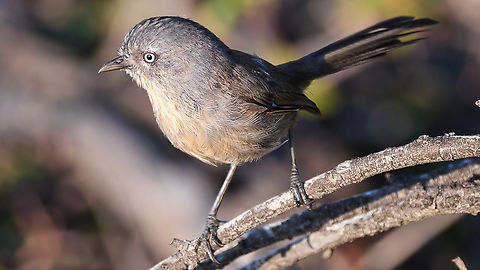
Appearance
The wrentit is a small, 15 cm bird with uniform dull olive, brown, or grayish plumage. It has short wings and a long tail often held high. It has a short bill and a pale iris. Given its retiring nature and loud voice, the wrentit is more likely to be detected by its call than by sight. The distinct sound that it makes is similar to the sound of a ping-pong ball falling on the table.Naming
Its systematics have been the subject of much debate, the wrentit having been placed in many different families by different authors for as long as it has been known to science. Its common name reflects the uncertainty, and its external resemblance to both tits and wrens. It is by no means closely related to either, however, and more recent and comprehensive phylogenetic studies support it belonging to the parrotbills.Distribution
The wrentit is a sedentary resident of a narrow strip of coastal habitat along the western coast of North America, being found from Oregon south through California, to Baja California, the northern state of the Baja California peninsula.It is usually restricted to certain chaparral and woodland habitats. It nests in 1 metre high shrubs such as poison oak, coyote bush and California blackberry. Logging and other changes in habitat have led to this species expanding its range recently, particularly northwards.
Habitat
Wrentits mate for life, forming pair bonds only a few months after hatching. Both sexes sing; the faster rhythm of the male's song is one of the few ways to differentiate the sexes. Both sexes also defend their territory year-round and participate in building the nest, a four-stage process that takes about two weeks. The three or four eggs are incubated for 14 days, again by both sexes. The chicks fledge after 15 days and are fed by their parents for another 40 days.The wrentit feeds by skulking through dense scrub gleaning exposed insects found by sight. It feeds primarily on beetles, caterpillars, bugs, and ants, but also takes small berries and seeds.
References:
Some text fragments are auto parsed from Wikipedia.